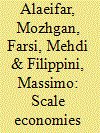| Srl | Item |
| 1 |
ID:
171468


|
|
|
|
|
| Summary/Abstract |
In this article, we investigate the heterogeneity in the responsiveness of Swiss household electricity demand to changes in prices and income. We focus on segments of consumers with different intensities of electricity consumption by using a panel quantile regression approach. This estimation strategy is applied to a rich micro-level longitudinal data set of 3880 observations from more than 1400 households, matched with a unique price data set extracted from the Swiss electricity regulator's online sources. While the findings show an inelastic electricity demand across all groups, an interesting pattern of variation emerges between lower and upper quantiles of electricity demand, respectively frugal and intensive users. Results show that households in the first conditional quartile and at the median react significantly to changes in prices, while those at the lowest quantile and upper quantiles exhibit insignificant price elasticities. The main policy implications of this work concern the design of price-based measures for reducing electricity consumption in the residential sector and the possibility of accounting for individual responses in tailoring policies for specific consumer segments.
|
|
|
|
|
|
|
|
|
|
|
|
|
|
|
|
| 2 |
ID:
096146


|
|
|
|
|
| Publication |
2010.
|
| Summary/Abstract |
This paper uses a random utility model to estimate consumers' valuation of energy efficient insulation and ventilation systems in rental apartments. Given consumers' limited experience in residential buildings and the perceived uncertainty about their comfort benefits and resulting energy savings, these relatively new technologies might be undervalued by risk-averse consumers. Using the concept of certainty-equivalence, this paper proposes a model to assess the consumers' risk-aversion for adopting energy-efficient systems. These systems are treated as risky assets while conventional commodities are assumed to be risk-free. The curvature of the utility function is interpreted as a measure of aversion to perceived risks as opposed to explicit risks measured by observed variances. The proposed formulation is applicable in stated preference data with qualitative variables. The model is applied to data from a choice experiment conducted among 264 apartment tenants in Switzerland. The estimated curvatures reject the risk-neutrality hypothesis. The range of the estimated risk premiums suggests that risk considerations remain a central issue in dealing with energy efficiency in residential buildings. The analysis also indicates that assuming same risk attitudes toward new and conventional systems could bias the estimates of the willingness to pay, especially when the system is comprised of several components.
|
|
|
|
|
|
|
|
|
|
|
|
|
|
|
|
| 3 |
ID:
127198


|
|
|
|
|
| Publication |
2014.
|
| Summary/Abstract |
This paper studies the cost structure of Swiss gas distribution utilities. Several econometric models are applied to a panel of 26 companies over 1996-2000. Our main objective is to estimate the optimal size and scale economies of the industry and to study their possible variation with respect to network characteristics. The results indicate the presence of unexploited scale economies. However, very large companies in the sample and companies with a disproportionate mixture of output and density present an exception. Furthermore, the estimated optimal size for majority of companies in the sample has shown a value far greater than the actual size, suggesting remarkable efficiency gains by reorganization of the industry. The results also highlight the effect of customer density on optimal size. Networks with higher density or greater complexity have a lower optimal size
|
|
|
|
|
|
|
|
|
|
|
|
|
|
|
|